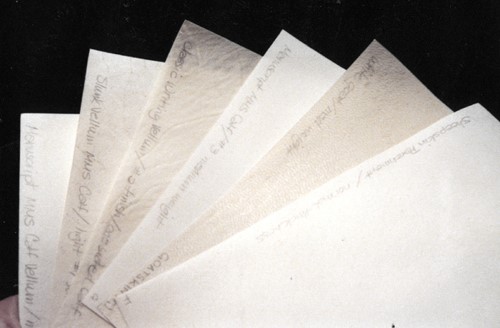 Photo 1
Photo 1
Vellum is the proper name given for any high quality animal skin excluding sheep or lamb.
Identifying any art being framed is indeed the job of a skilled custom framer, and as simple as the words parchment, vellum and tracing vellum are there can be a great deal of confusion over them. Learn to identify your art, including the materials it is made from.
Very Brief History
In ancient times the preparation of skins for writing was crude. Archbishop Hildeberg of Tours in the 11th century tells that prior to writing on skin the scribe cleaned remains of fat and other impurities with a razor then pumiced it with a stone to smooth and remove tendon lines. On the other hand, it was said that Cicero had an extensive library of parchment in which there existed a parchment so fine that the whole story of The Iliad was written upon it and fitted into a nutshell.
The use of vellum animal skins for recording history has long been an accepted practice, and skins have survived from as early as Egypt 2500 BC. Calf, goat and sheep were normally used, but skins of gazelle, antelope, stag and ostrich have been uncovered and preserved. (photo 1) Often used in bookbinding, vellum is the proper name given for any high quality animal skin excluding sheep or lamb. Though all writing skins are often referred to as parchment, the only true parchment comes from sheep.
 Photo 1
Photo 1
Vellum is the proper name given for any high quality animal skin excluding sheep or lamb.
Today the term parchment is often used in non-technical contexts to refer to any animal skin, particularly goat, sheep or cow that has been scraped or dried under tension. The term originally referred only to the skin of sheep and goats, whereas vellum is made from calfskin, and considered finer quality. However, when old books and documents are encountered it may be difficult, without scientific analysis, to determine the precise animal origin of a skin either in terms of its species, or in terms of the animal's age. It is for all these reasons that modern conservators, librarians and archivists prefer to use the singular word parchment or the neutral term animal membrane. (photo 2)
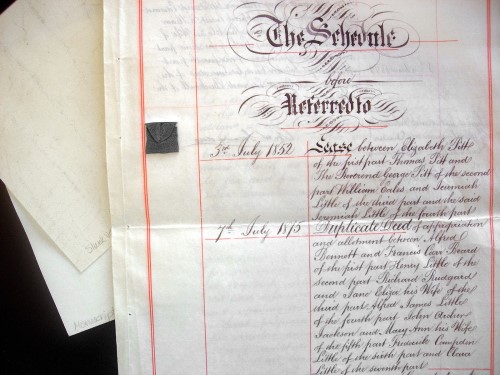 Photo 2
Photo 2
This leger page is from sheepskin, called parchment. Modern conservators, librarians and archivists prefer to use the singular word parchment or the neutral term animal membrane.
Parchment
Genuine sheepskin parchment is used for printing, writing and bookbinding whenever excellence or distinction is desired. This is the reason many Ivy League universities continue to produce diplomas on original sheepskin instead of artificial parchment or fine grade printing paper.
The skins from sheep are whiter and oilier than vellum. To prepare them sheepskins are first pickled for storage then in large batches are depickled, scraped, limed, then finally squeezed to remove moisture. Skins are then tied to a wooden frame at 21 points around the edge of the skin, and allowed to dry 5-6 days. The skins are then scraped (for the second and third times), degreased, shaved, pumiced, purified, and whitened, all by hand. Then they are set aside to dry slowly to ensure a flat even skin. Dried skins are cut from the wooden frame for finishing and/or cutting into smaller pieces.
Vellum
Though the process for preparing vellum is similar to sheepskin, while sheepskins are sorted and selected after dewooling, calfskins and goatskins are selected prior to dehairing. After the hair has been removed, there is a long liming process lasting up to four weeks. Shaving of vellums takes much longer and is more difficult, requiring much greater skill for it is easy to remove too much or too little of the skin reducing its value.
New skins are generally stored rolled and reverse rolling will lay them flat. Most vellum is sold as whole skins unlike sheepskin parchment which is also available in sized rectangular shapes. Vellums are generally creamy in color and often showcase the veining of the animal, while parchment is whiter and has a much smoother surface. Unlike paper, the preparation of natural animal skin cannot be mechanized.
Skins Today
Though the use of animal skins appears to be more limited to university diplomas in the United States, in other parts of the world it is extensively used for everything from religious documents and wedding invitations to royal proclamations. No two skins are truly alike, identifying that as part of their natural beauty and the basis for framing them true to their nature. Fully mounting a piece of parchment or vellum using any process restricts it from the natural expansion and contraction it craves as a real skin through variations in relative humidity. A skin document or diploma should be hinged, sink mounted, or conservationally supported with edge strips or corner pockets, but never firmly bonded to a backing board as was thought decades ago. If a document is slightly buckled it is the nature of the beast and is truly a part of the total effect and appearance, it should be allowed to thrive.
Flattening Skins
If a cracked, wrinkled, or rolled document has been brought in and needs to be made flat, the best advice for the framer is not to suggest mounting at all. It is the duty of the frame designer to educate their client about proper care and maintenance of their irreplaceable, one-of-a-kind keepsake. But in order to frame they may require flattening. If it has become dry and brittle, forcing it flat could crack the skin or damage painted decoration, so, humidifying and flattening procedures of this type may require the expertise of a qualified book or paper conservator.
If proceeding on your own, the relaxing and flattening a document at the very least may involve humidifying in a chamber, at worst soaking in water. After it has relaxed it must then be slowly dried flat between top and bottom layers of polyester Pellon—to prevent sticking to the skin—and blotters—to absorb the moisture, beneath an even glass or metal weight during the full drying process. There are many areas that require testing prior to humidifying or submerging a document, such as testing for ink and paint permanence, and taking note of wax seals. Such seals will also limit the even weight pressure during the drying process, so be aware.
Also skins will react differently depending upon whether they are parchment of vellum resulting from how they were prepared for use. Since vellums are originally dried on frames much like stretcher bars, when dampened they will attempt to revert to the original shape of the animal as they dry if left under no restraints. So to reflatten vellum, it must be dampened and dried under tension or pressure, such as plate glass weights. The sheepskin parchment 1852 ledger page in photo 3 was incorrectly placed under heat to attempt to flatten it, creating a new counter-curve instead. Counter rolling may help correct this but it may still require a sink mount.
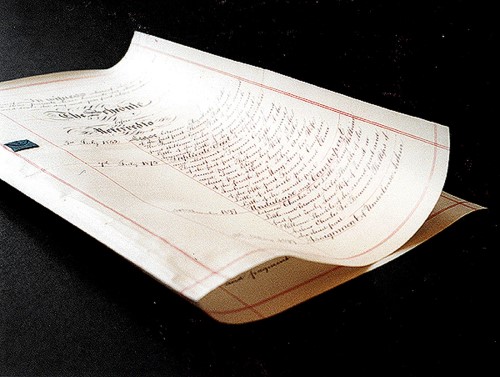 Photo 3
Photo 3
This ledger page was incorrectly placed under heat to attempt to flatten it and creating a new counter-curve instead by the combination of tolerable heat of 180°F, but excessing pressure.
Heat Application
Vellum tolerates greater temperature and moisture abuse than parchment. Applying heat alone to skins will not radically affect them as long as it is not too hot. Tests show that temperatures of 180°F for up to 5 minutes will not do damage to either vellum or parchment samples, although a tendency toward brittleness does begin to occur. The vellum sample in photo 4 was soaked in distilled water and allowed to freely air dry under no pressure, encouraging the lower right corner to cockle. The left side was then pressed flat at 160°F using a mechanical press. The upper portion was dry mounted to 4ply matboard using low temperature tissue at 165°F for 3 minutes then cooled under a glass weight.
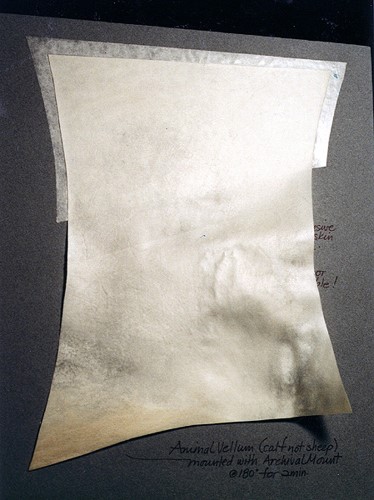 Photo 4
Photo 4
First soaked in distilled water then allowed to freely air dry under no pressure, encouraging it to cockle (lower right corner). Left side was then pressed flat at 160°F using a mechanical press. Top was dry mounted to 4ply matboard at 165°F for 3 minutes and cooled under a glass weight.
A combination of heat and pressure while damp will slightly shrink most vellum almost undetectably, while it may do major damage to parchment. Make certain any skin having been dampened to flatten is totally dry and clean of all other adhesives prior to mounting to avoid any irreversible damage. The left sample of photo 5 shows a piece of sheepskin that has been dampened and air-dried. There is about 5% natural shrinkage due to the original stretched cleaning process. The right sample shows damage resulting in applying both moisture and heat to the parchment at the same time.
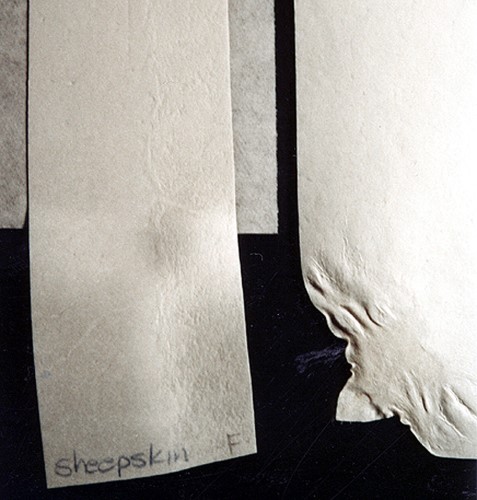 Photo 5
Photo 5
Sheepskin that has been dampened and air-dried (L). The right sample shows the unfortunate damage resulting in applying both moisture and heat to the parchment at the same time.
Vellum Paper
Heat and moisture can curl the sides of a sheet of translucent vellum as with the real animal skin. Place a scrap of vellum in the palm of your hand or under a lamp and watch the changes occur. If the edges do curl simply counter-curl to reflatten. Paper should be stored in a cool, dry place, be careful not to crease, always wear gloves when handling to prevent fingerprints, and avoid heat and moisture. It is used as tracing paper and a substrate for invitations, certificates and printing. (photo 6) These are in no way related to, nor similar to, the skins discussed in this article.
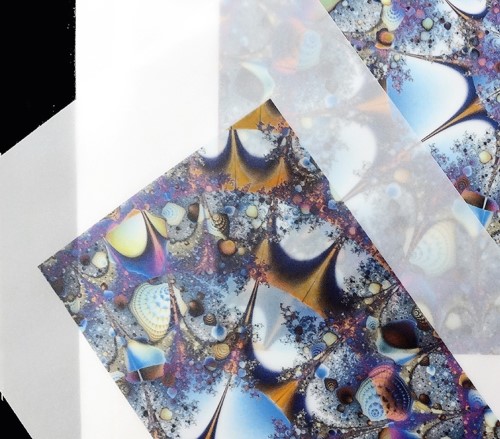 Photo 6
Photo 6
The PPFA PRINT 2019 by Richard Cryer is a perfect example of vellum. Frosted and satin vellum are used both as a tracing sheet and as a printing substrate for invitations, business cards, certificates, and fine art.
The terms parchment and vellum are both also used in the paper making industry. Parchment paper is made from cellulose fibers prepared from fir trees or plants such as cotton or flax, and papers can be made to resemble the thickness and surface of parchment. Imitation parchment paper has been developed for artists in aged, natural and white colors as acid-free and lignin-free for scrapbooking, invitations, certificates, calligraphers, and is also available for printing and office stationery in tinted colors. (photo 7)
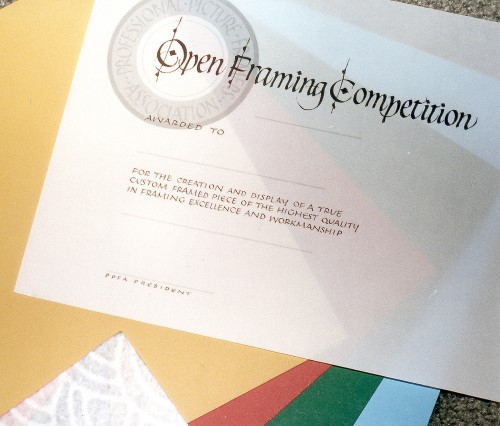 Photo 7
Photo 7
Translucent vellum paper was used as the substrate for a PPFA Award Certificate. By backing with a colored matboard the certificate will take on a pale color tint when framed.
Final Thought
Both stretched and mounted versions of presentation are unnatural to vellum and parchment, for it assumes an inconsistent character from the true natural look and behavior of a skin. Preservation techniques are favored and sink mounts are often a perfect solution to a buckled keepsake, and they should be displayed in a dry location out of direct sunlight. Taken well care of, these preserved masterpieces will last for generations.
END
Copyright © 2020 Chris A Paschke
Resources—Items
https://www.talasonline.com/Satin-Vellum-Paper—Satin Vellum Paper
https://www.strathmoreartist.com/specialty-parchment.html—400 Series Parchment, Tracing Vellum
https://www.lcipaper.com/kb/vellum-paper-tracing-paper.html—Vellum paper
https://www.archives.gov/preservation/formats/paper-vellum.html—Parchment, Vellum, Paper
https://www.conservation-wiki.com/wiki/BPG_Parchment—BPG Parchment Paper
https://www.talasonline.com/Calligraphers-Parchment-and-Vellum—Calligraphers Parchment and Vellum
https://en.wikipedia.org/wiki/Vellum—Vellum
For more articles on mounting basics look under the mounting section in Articles by Subject.
Additional information on all types of mounting is found in:
The Mounting and Laminating Handbook, Second Edition, 2002,
The Mounting And Laminating Handbook, Third Edition, 2008 and
Creative Mounting, Wrapping, And Laminating, 2000 will teach you everything you need to know about getting the most from your dry mount equipment and materials as an innovative frame designer.
All books are available from Designs Ink Publishing through this website.
Chris A Paschke, CPF GCF
Designs Ink
Designs Ink Publishing
785 Tucker Road, Suite G-183
Tehachapi, CA 93561
P 661-821-2188
chris@designsinkart.com